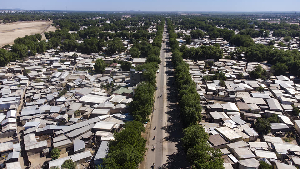In spite of the heavy floods that have affected most of the North Region, life is stabilising.
Life is gradually returning to normal in most localities of the North Region following heavy downpour that led to floods which killed about 14 people, caused six disappearances and destroyed several houses and properties. The situation has kept the local administration, elite of the northern part of Cameroon and the international community concerned.
While the local population today keep praying whenever the skies get cloudy around Garoua, the administrative officials have remained optimistic, assuring that the situation is under control, to quote North Governor, Otto Wilson Joseph and the SDO for Benoué, Zang III in various chats with Cameroon Tribune in Garoua on Saturday September 15, 2012.
Although it has not rained again in Garoua for the past six days, the waters of the River Benoué on the outskirts of the city continue to present a worrisome picture. Standing on the River banks, the widths of the Benoué still spans over tens of kilometres covering areas that were formerly virgin land. It appears like a sea or even the Atlantic Ocean. The only signs of life are tree-tops that remain visible after the floods have covered the rest of the trees. AES-Sonel electric polls made of iron that have also resisted the floods even conjure a more frightening picture as they stand tall in the middle of the waters as if to remind onlookers that no human intervention is possible in case of any break down.
Destruction
Some localities along the banks of River Benoué on the way to Mayo Rey Division are in darkness for weeks now following the floods that damaged one of the electric polls. The heavy rains that affected most of the region completely cut-off access roads to areas such as Poli Sub-Division in the Faro Division and the Rey Bouba Lamidat in the Mayo Rey Division from the rest of the Capital, Garoua. Inhabitants of such localities have therefore been forced to either lead a sedentary life or communicate only with neighbouring countries.
In the Benoué Division, that also hosts the Regional capital of Garoua, 118 villages have been affected by the floods. Apart from several houses that continue to be submerged, school kids have also been squatting in other campuses as waters and flood victims took over their school campuses. Ecole Public Benoué I and II constructed by the Japanese at Liddiré is only surviving thanks to the surrounding fence that prevented much water from entering. As houses around the school took in water, their inhabitant moved to the school premises with their children and whatever belonging they could take along.
Pupils of the Benoué I and II Primary School have therefore relocated to Government Primary School (G.S.) Garoua I and II where special hours have been provided for them to attend classes. As expected, some parents are hesitant to allow their kids cover the distance to G.S. Garoua, insisting that their kids will only go back to school when life gets back to normal at Liddiré. Yet, the level of water in the neighbourhood is not diminishing. The result has been repeated calls by head teachers and the local authorities to convince parents to send their kids to school.
General mobilisation
Given the complexity of the situation, the Governor of the North Region, Otto Wilson Joseph has created a crisis committee which he is heading, assisted by the Senior Divisional Officer for Benoué Zang III. The work of the committee has been to channel humanitarian aid to the flood victims while watching against any further danger caused by the downpour.
Since the torrential rains began on August 21, 2012, several calls for compassion have been accompanied by the arrival of various delegations to assistance and comfort the victims. The most recent was the arrival of the Minister of Basic Education, Mme Youssouf née Adidja Alim who moved round the affected primary schools on Friday September 14, 2012. She later joined the elite of the northern regions, under the leadership of Zacharie Perevet to present another consignment of gifts to the Governor of the North Region to help the victims.
While reassuring the population that the situation is under control, Governor Otto Wilson Joseph has not only rejected claims that the deluge was caused by water from the Lagdo Dam, he has insisted that measures are in place to protect lives and property. He said once AES-Sonel informed him of the impact of the torrential rains on August 24, he took measures to have neighbouring Nigeria alerted before authorising that some of the waters be liberated from the dam. He noted that the rains were releasing 10,000 cubic metres of water per second into the dam and he authorised that only 30,000 cubic metres of that amount should be allowed out of the dam per second. The real problem, he added was floods from the Mayo Kebbi in Chad, a tributary River that empties all its contents into River Benoué River. He argued that the situation requires a long term solution through the construction of another dam.
Actualités Régionales of Monday, 17 September 2012
Source: Cameroon Tribune












